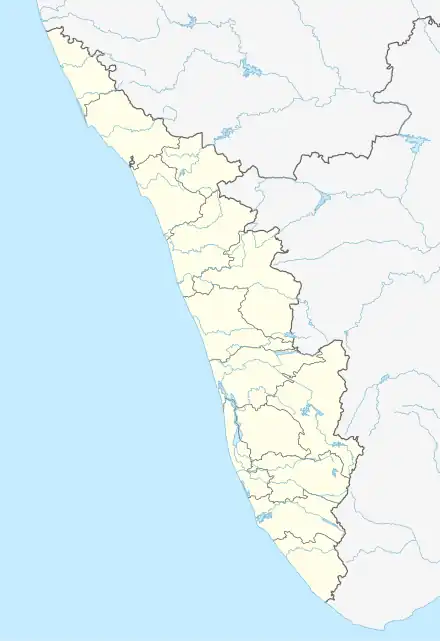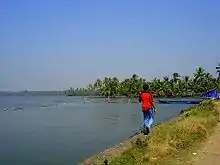Kumbalangi
Kumbalangi is an island village in the outskirts of Kochi city in the state of Kerala, India. Situated amidst backwaters, around 12 km (7.5 mi) from the city center, Kumbalangi is a major tourist attraction and is famous for its Chinese fishing nets. It is also known among the tourists for the occurrence of the natural phenomenon known as sea sparkle or bioluminescence in the backwaters at Kumbalangi, which is locally known as Kavaru.[1] It is the first eco-tourism village in India, according to the government agency Kerala Tourism.[2]
Kumbalangi | |
|---|---|
 Kumbalangi Location in Kerala, India  Kumbalangi Kumbalangi (India) | |
| Coordinates: 9.88°N 76.29°E | |
| Country | |
| State | Kerala |
| District | Ernakulam |
| Government | |
| • Type | Panchayat. |
| Population (2001) | |
| • Total | 40,331 |
| Languages | |
| • Official | Malayalam, English |
| Time zone | UTC+5:30 (IST) |
| PIN | 682007 |
| Vehicle registration | KL-7 / KL-43 |
| Nearest city | Kochi |



Location and geography
Kumbalangi island is 16 km2 in area. It is situated around 15 km from the Ernakulam Junction Railway Station and around 40 km from the Cochin International Airport.
Population and economy
Over 40,000 people live in the village. According to the Census 2011, majority of the people are Latin Catholic Christians who constitute 75% of the population, and also has a 96% literacy rate.
The main occupation in Kumbalangy is fishing, and there are over 100 Chinese nets in the backwaters that face the village. Groves of mangroves separate the land from the water, providing a breeding ground for prawns, crabs, oysters and small fishes. It is home to fishermen, farmers, labourers, toddy tappers and coir spinners.
An occupation which has seen quite a revival is that of boatmen. The village is well connected by road to the mainland, and the local community did not patronize them very much. However, tourists are keen on cruises. Fisher folk and boatmen also demonstrate various fishing techniques for the tourists.
Model tourism village
In 2003 the Kerala government selected several villages as model villages. The Kumbalangy Integrated Tourism Village project is meant to transform the tiny island into a model fishing village and tourism spot. The panchayat (village council), with financial assistance from the state government, is implementing the project.
"The Kumbalangy project was set in motion in 2003 to help the local people, the economy and the locality through tourism," says M C Sivadathan, President of the Kumbalangy panchayat. "And in order to achieve this, we have done away with many concepts typical of tourism elsewhere. Our idea is to create job opportunities for the villagers, while also ensuring that tourists have a good time seeing and experiencing real village life," he explains.[3]
Currently, ten houses offer rooms to visitors. This facility is generally within a residence, where two or more rooms with attached baths are set aside for guests. The tourists sit with the host family and eat the same food. They can walk through the village, watch fishermen at work, fish themselves, go canoeing and visit the farms. Tourists also find that there is no huge communication gap, because at least one member in a family, if not all, can converse in English.
Artists' village
Under the Kumbalangy project, Kalagraamam, an artists' village, is also being set up. The initial plans were to erect a cottage in the middle of the backwaters. Later, the panchayat members, tourism secretary and the tourism minister all agreed that this would disturb the backwaters ecology. Kalagraamam, therefore, will now stand on four acres of land inside Kumbalangy. It will showcase the traditional fishing equipment and handicrafts of the region.
Infrastructure
The Kumbalangy panchayat is aware that being a tourist destination also brings with it greater responsibilities.
"Tourists will not come unless there are proper roads and lights. So, the roads and canals have been strengthened, CFC lamps have been installed, and 600 biogas plants have been set up for waste management. Kumbalangy is also the first panchayat in the state to set up such a waste management system. A park has also been constructed for visitors to relax in. The most remarkable thing about this project is that what we do for the tourists also directly benefits the local population," Sivadathan says.
Schools
Schools in Kumbalangi include:[4]
- St Peter's Higher Secondary School
- Our Lady of Fatima Higher Secondary School
- St Anne's Public School
- Government UP School
- St George's UP School
- Illikkal VPY LP School
- St Joseph's LP School
In popular culture and kavaru
The 2019 state award winning Malayalam-language movie Kumbalangi Nights is set here.[5] After the release of the movie, Kumbalangi became more known to tourists because of the depiction of sea sparkle (Kavaru) phenomenon at backwaters of Kumbalangi in the movie. Sea sparkle can be witnessed along the backwaters during March-April. As the wind creates ripples on the waters, the phenomenon becomes more visible. The sight is more alluring on moonlit nights.[6]
References
- "Kumbalangi witnesses 'Kavaru' again as bioluminescence appears in Kochi's backwaters". OnManorama. Retrieved 6 March 2023.
- "Kumbalangi, Eco-friendly, Tourist Village, Kochi, Ernakulam, Kerala, India". Kerala Tourism - Kochi. Retrieved 12 July 2021.
- Chowdhary, Charu (25 February 2019). "Kumbalangi: An Eco-Tourism Paradise Off Kochi". India News, Breaking News | India.com. Retrieved 12 July 2021.
- "Schools in Kumbalangy - Ernakulam district of Kerala". study4sure.com. Retrieved 25 July 2022.
- "50th Kerala State Film Awards: Winners list". The Indian Express. 13 October 2020. Archived from the original on 15 October 2020. Retrieved 14 October 2020.
- "The 'magical glow' in the waters in 'Kumbalangi Nights': The secret behind the sparkle". The News Minute. 17 February 2019. Retrieved 6 March 2023.